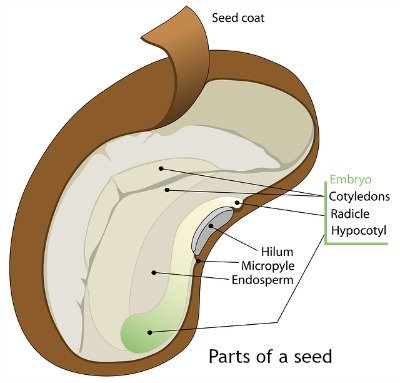There are three basic parts of a seed in the angiosperms:
(a) an embryo,
(b) food storage or nutritive tissue,
and (c) seed covering.
Embryo
A mature seed has a diploid (2N) embryo which develops from a fertilized egg or zygote.
It results from the union of a sperm (1N), from a germinated pollen, with a female egg (1N) in the embryo sac.
It is the embryo that ultimately gives rise to a new plant.
The embryo can be distinguished from the other major parts of the seed based on component parts and function.
It consists of the epicotyl, hypocotyl, radicle, and one or two cotyledons.
It is the one that develops into a plant with an upward growing shoot and a downward growing root system.

The epicotyl is a tiny shoot from which the entire plant shoot system develops. The growing tip of the epicotyl is the plumule.
The hypocotyl is the transition zone between the rudimentary root and shoot; the radicle is a small embryonic root.
Cotyledons are specialized seed leaves that develop from the plumule and occur singly in most monocot seeds but two in dicot seeds.
They are the most prominent parts of a fully developed embryo.
Monocot means one cotyledon while dicot means two cotyledons. (Click here to read the relevant update)
The stored food is present in most seeds in the form of carbohydrates, fats, and proteins.
This stored food may be found in the following parts of a seed: endosperm, cotyledons, or the perisperm.
The stored food is used to support the embryo during seed germination.
But in orchid seeds, a functional storage tissue is lacking.
Storage Tissue or Nutritive Tissue
The endosperm differs from other parts of a seed by having a triploid chromosome complement (3N).
It results from the union of one sperm nucleus (1N), from germinating pollen, with the two polar nuclei (2N) in the embryo sac.
In corn and other cereals, it represents the major bulk of the seed.
In other seeds (e.g. beans), the endosperm is absent because it is utilized in the development of the embryo. In this case, the cotyledons, not the endosperm, serve as the food-storage tissue.
This is an example that of the different parts of a seed, the endosperm may be wanting.
The endosperm can be described as either mealy, horny, continuous, or ruminated.
It is mealy when granular, horny when hard and bone-like, continuous when smooth and uninterrupted, and ruminated when there are irregular depressions, as if chewed, as in betel nut (Areca catechu).
Coconut water is the liquid endosperm.
When the plant food is stored outside of the embryo in a large endosperm, the seed is called albuminous.
When the embryo stores its own food reserve, usually within the cotyledons, the seed is called exalbuminous.
In the latter case, the endosperm is absent, having been digested by the embryo during development, or it is reduced to a thin layer around the embryo.
The perisperm is a storage tissue that originates from the nucellus.
Thus, just like other parts of seed other than the endosperm, it has a diploid chromosomal content.
But it occurs only in a few families, e.g. Amaranthaceae (amaranth family), Chenopodiaceae (goosefoot family), and Caryopyllaceae (pink (family).
It is usually digested by the endosperm during seed development.
Seed Covering or Protective Coat
The seed covering is of maternal origin.
This part of a seed consists of the seed coat or remnants of the nucellus and endosperm. Sometimes it consists of parts of the fruit.
It covers and provides mechanical protection to the other parts of a seed.
The seed coat is usually hard, thickened, brownish, or otherwise colored, and partly impermeable to water.
It prevents excessive loss of water from within the seed and serves as a barrier against the entry of parasites.
Hard seed coats cause dormancy, a condition that prevents germination when environmental conditions are not favorable for the sustained growth of seedlings.
The seed coat is developed from the outer covering of the ovule, or integument.
But it is not immediately apparent in the angiosperms because the seed is encased in a fruit wall or pericarp.
The outermost, visible part of the corn kernel is in fact the exocarp, the outermost part of the pericarp.
There are usually two layers of the seed coat.
The outer layer, known as the testa, is thicker. The inner one is more delicate, known as tegmen.
Externally, some parts of a seed are obvious.
On some seed coats, the opening in the integuments of the ovule, called micropyle, is visible.
The hilum is usually visible also, the scar left by the stalk which attached the seed to the placenta.
The hilum is equivalent to the navel in humans to which the umbilical cord is attached.
It appears dark in color when the seed becomes physiologically mature and is thus used as an indicator of seed maturity.
From the outside, seeds may be smooth, wrinkled, or hairy as in cotton, or winged.
In the castor bean (Ricinus communis), there is wart-like growth at the hilum, called the caruncle.
In mangosteen, the seeds are enveloped by a white fleshy aril which is edible.
Note: Do you know that some seeds used in propagating plants may not be entirely seeds? Click here to read.
